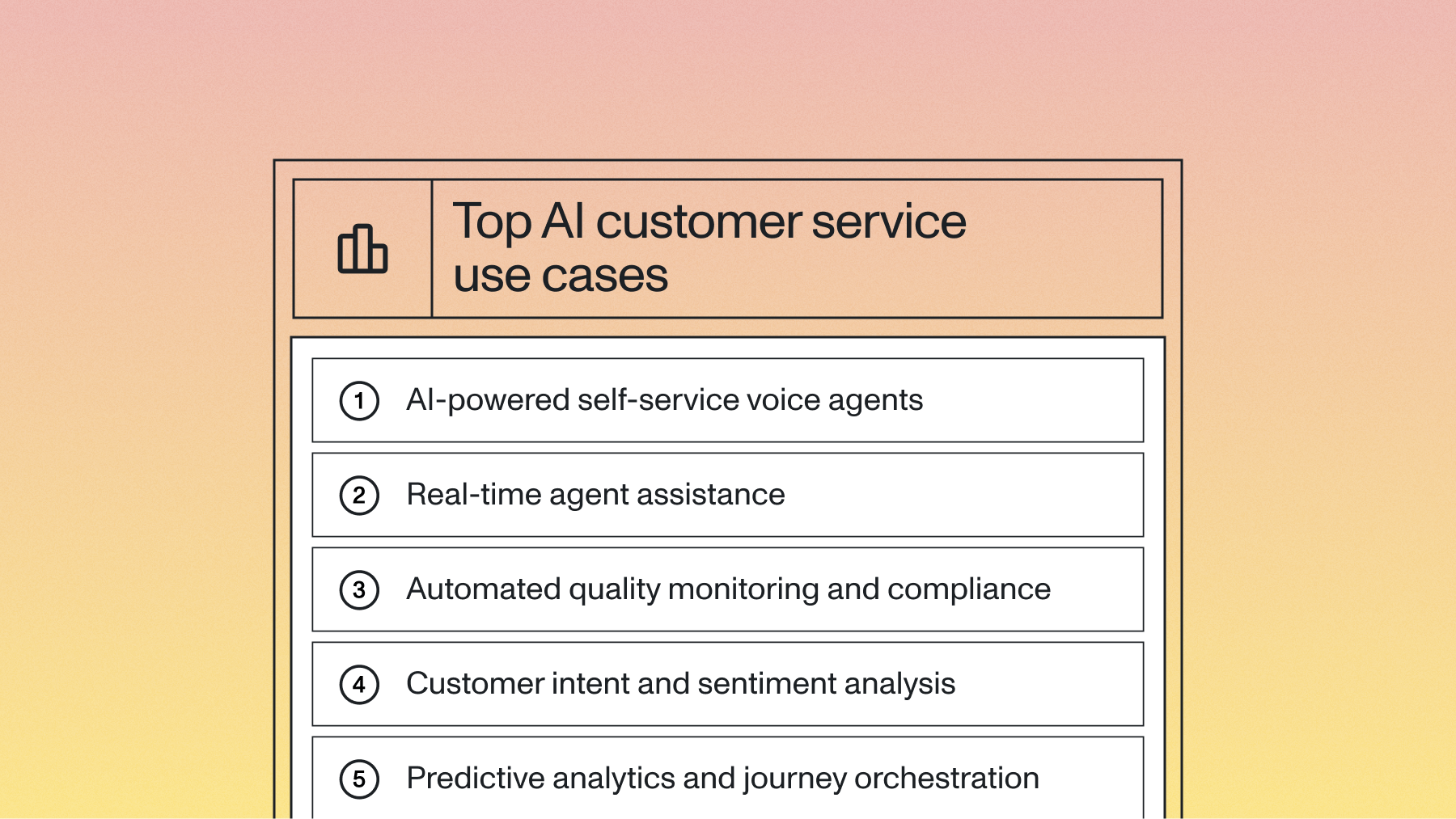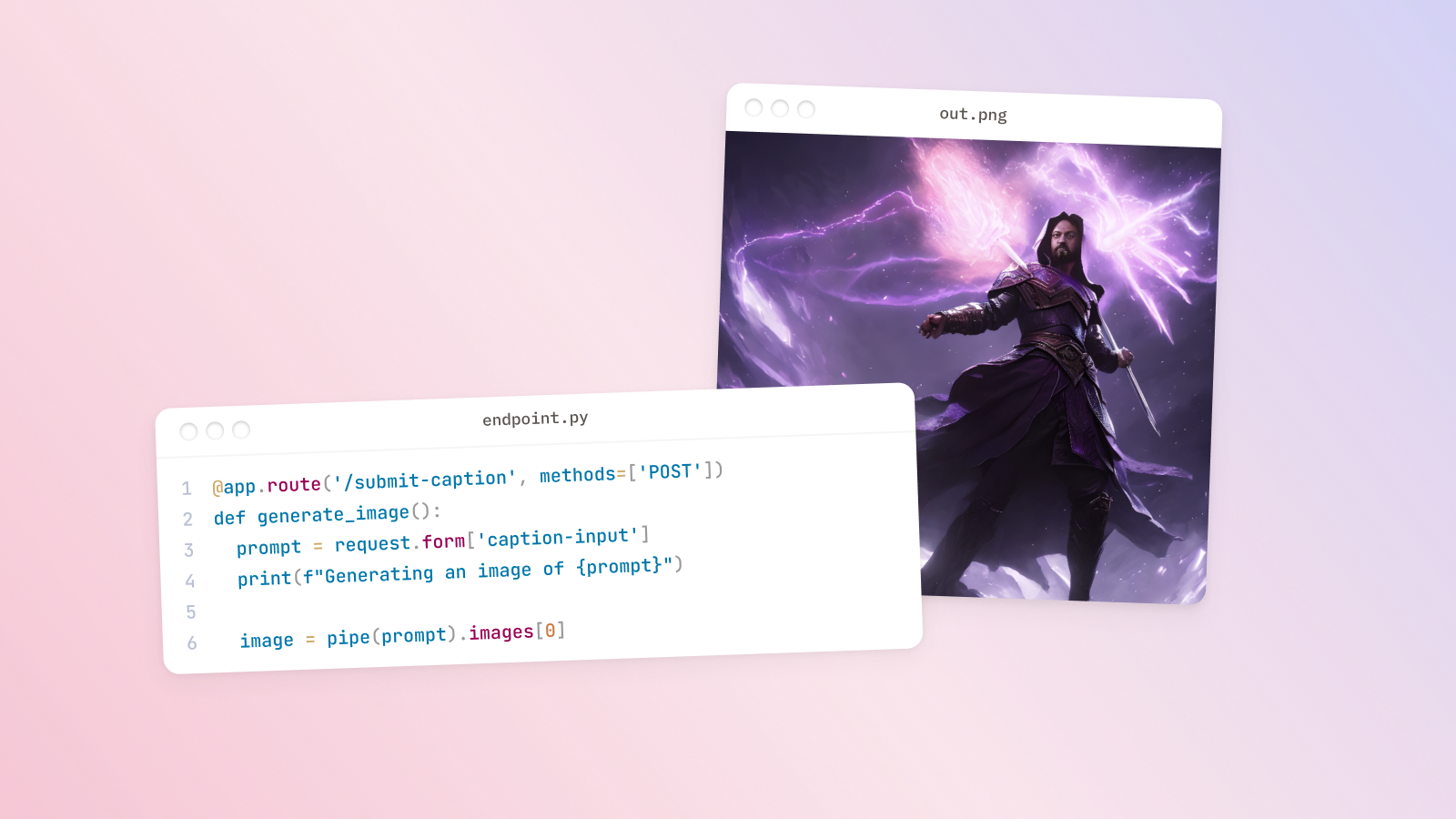AI in customer service: Top use cases for 2026
AI customer service streamlines support by automating routine tasks, improving response times, and delivering personalized experiences for every customer.



AI transforms customer service by automating routine interactions, assisting human agents in real-time, and providing insights that improve the entire customer experience. Companies now deploy voice agents that handle complete phone conversations, AI systems that coach agents during calls, and analytics that predict customer needs before problems escalate.
This guide covers the six most impactful AI customer service use cases for 2026, from self-service voice agents to predictive analytics. You'll learn how each technology works, what implementation challenges to expect, and how to measure success. We'll also explore the technical architecture behind voice agents and the speech-to-text accuracy requirements that make or break customer interactions.
What is AI in customer service
AI in customer service is software that uses artificial intelligence to help answer customer questions and solve problems automatically. This means instead of waiting for a human agent, customers can get help from AI systems that understand natural language and provide instant responses.
You've probably experienced basic versions of this, like chatbots on websites or phone systems that understand what you're saying instead of making you press numbers. But modern AI customer service goes much deeper. It can detect if you're frustrated, find exactly the right information to help you, and even complete transactions like booking appointments or processing returns.
The key difference from old phone menus is that AI understands context. When you say "I need help with my order," the AI knows to look up your account and recent purchases instead of asking you to navigate through endless menu options.
Here's what makes AI customer service work:
- Speech-to-text models: Convert your spoken words into text the computer can understand
- Natural language processing: Figure out what you actually want, not just the words you used
- Knowledge bases: Access all the company's information to find the right answer
- Response generation: Create helpful, human-like responses using Large Language Models like those accessible through AssemblyAI's LLM Gateway
- Integration systems: Connect with your account, order history, and other business systems
Top AI customer service use cases in 2026
AI transforms customer service in six main ways. Each solves specific problems you've probably experienced as a customer, such as long hold times, getting transferred multiple times, or repeating your information over and over.
AI-powered self-service voice agents
Voice agents are AI systems you can talk to over the phone like a human customer service rep. This means you call a company and have a normal conversation with an AI that can help you complete tasks, not just route your call.
Unlike old phone trees where you press numbers, voice agents understand when you say things like "I want to reschedule my appointment for next week" or "My last payment didn't go through." They can access your account, check availability, and make the changes while you're talking.
Voice agents handle these common requests:
- Checking account balances and payment history
- Scheduling, changing, or canceling appointments
- Tracking orders and processing returns
- Resetting passwords and updating contact information
- Answering basic questions about products or services
The technology depends heavily on accurate speech-to-text processing. If the system mishears your account number or name, the whole interaction fails. That's why the underlying Voice AI models need to capture exactly what you're saying, especially for important details like numbers and proper nouns.
Real-time agent assistance
Real-time agent assistance gives human customer service reps an AI assistant that helps them during phone calls with customers. This means while you're explaining your problem, the AI is searching for solutions and suggesting responses to the agent.
The AI listens to both sides of the conversation and instantly pulls up relevant information. If you mention a specific product issue, helpful articles appear on the agent's screen. If you sound frustrated, the system alerts the supervisor that you might need extra attention.
- Instant knowledge access: Relevant help articles and procedures pop up automatically
- Response suggestions: AI recommends what the agent should say based on similar successful calls
- Escalation alerts: System warns supervisors when calls are going poorly
- Automatic note-taking: Creates summary of the conversation for follow-up
This helps new agents perform like experienced ones and keeps everyone consistent in how they handle different types of problems.
Automated quality monitoring and compliance
Automated quality monitoring means conversation intelligence listens to and analyzes every customer conversation instead of just checking a few random calls. This gives managers a complete picture of how their team is performing and where they need improvement.
The AI can track whether agents are following company scripts, being polite to customers, and following legal requirements. In industries like banking or healthcare, this helps ensure compliance with strict regulations.
Instead of manually reviewing a tiny sample of calls, you get insights from every interaction. The system identifies coaching opportunities, flags potential problems, and tracks improvements over time.
Customer intent and sentiment analysis
Intent and sentiment analysis means AI figures out why customers are contacting support and how they feel about the interaction. This helps companies be proactive instead of just reactive to problems.
When multiple customers call about the same issue, the AI spots the pattern immediately and alerts the right teams. If customers start sounding more frustrated than usual, managers know there might be a bigger problem developing.
The technology goes beyond just positive or negative feelings:
- Frustration detection: Identifies when customers are getting upset before they hang up
- Churn prediction: Spots language patterns that suggest customers might leave
- Issue trending: Notices when the same problems keep coming up
- Success indicators: Recognizes when interactions are going well
This information helps improve products and services based on real customer feedback.
Predictive analytics and journey orchestration
Predictive analytics uses past customer interactions to predict what will happen in the future and make better decisions. This means the AI learns from millions of previous conversations to forecast busy periods, recommend staffing levels, and personalize each customer's experience.
Journey orchestration uses these predictions to guide customers to the best solution for their specific situation. If you usually prefer self-service options, the system might send you a helpful video instead of connecting you to an agent immediately.
The AI learns what works best for different types of customers and situations. Someone with technical expertise might skip basic troubleshooting steps, while someone new to the product gets more detailed explanations.
Intelligent routing and workflow automation
Intelligent routing means the AI decides which agent should handle your call based on your specific needs, not just who's available next. This ensures you get connected to someone who actually knows how to help with your particular issue.
The system considers your history with the company, the complexity of your problem, and which agents have the best track record with similar issues. Instead of getting transferred multiple times, you reach the right person immediately.
Workflow automation handles all the boring administrative tasks automatically:
- Creating support tickets with proper categories and priorities
- Scheduling follow-up calls and sending confirmations
- Updating your account information across all systems
- Routing complex issues to specialists without delay
This means agents spend more time actually helping customers instead of filling out forms and managing paperwork.
How voice agents work in customer service
Voice agents combine multiple AI technologies to create conversations that feel natural and solve problems. Understanding how these pieces fit together helps you know what to expect and how to evaluate different solutions.
Core components and technical architecture
A voice agent needs five main components working together seamlessly. Each part has a specific job, but they all need to work fast enough that conversations feel natural.
The foundation is speech-to-text technology that converts what you say into text the computer can process. This happens in real-time while you're talking, not after you finish speaking. The accuracy of this step determines everything else—if the system mishears "account number 12345," it can't help you.
Next, conversational AI powered by Large Language Models analyzes that text to understand what you actually want. AssemblyAI's LLM Gateway provides access to these models, enabling natural conversation flow and contextual understanding. This isn't just matching keywords. It's understanding context, remembering what you said earlier in the conversation, and figuring out the best way to help you.
Finally, text-to-speech converts the response back into natural-sounding speech. Modern systems can adjust tone and emphasis to sound more human and match the mood of the conversation.
Integration with existing customer service systems
Voice agents need to connect with your company's existing systems to access account information and actually complete tasks. Without these connections, the AI can only provide generic information, but it can't look up your specific order or update your account.
The most important integration is with customer relationship management (CRM) systems. This lets the voice agent see your contact history, previous purchases, and current account status. When you call, it already knows who you are and can reference past interactions.
Knowledge base integration ensures the voice agent has access to current, accurate information. When policies change or new products launch, the AI automatically knows about these updates and can share them with customers.
Common integration challenges include keeping data synchronized across systems, handling authentication securely, and managing what happens when connections fail. The best implementations plan for these issues upfront and test thoroughly before going live.
Implementation considerations and success metrics
Starting with AI customer service requires careful planning and realistic expectations. Companies that rush implementation without proper preparation often create more frustration for customers instead of solving problems.
Choosing the right use case to start
Begin with simple, high-volume tasks that have clear success criteria. Account balance inquiries, appointment scheduling, and order status checks work well because they follow predictable patterns and have obvious right or wrong answers.
Avoid complex troubleshooting or emotionally charged situations initially. Technical support for multiple products or billing disputes require nuance that's better handled by experienced human agents while your AI system learns and improves.
Consider these factors when picking your first use case:
- High volume: Enough daily interactions to justify the automation effort
- Clear process: Straightforward steps with predictable outcomes
- Available data: Existing documentation and examples to train the AI
- Measurable success: Easy to tell if the interaction worked or failed
Start small, measure results, and expand gradually as you learn what works best for your customers and your business.
Measuring ROI and success metrics
Track both customer satisfaction and operational efficiency to understand whether your AI implementation is actually working. Customer satisfaction scores tell you if automation improves the experience or makes it worse. Resolution rates show whether the AI actually solves problems or just deflects them.
Focus on metrics that matter to both customers and your business:
- Customer satisfaction: Post-interaction ratings and feedback
- First-call resolution: Problems solved without transfers or callbacks
- Average handle time: Total interaction duration including follow-up work
- Cost per interaction: Total operational cost divided by number of interactions handled
- Completion rate: Voice agent conversations finished without human handoff
- Error rate: Interactions that failed due to misunderstanding or technical issues
Monitor these metrics daily during initial deployment and weekly once the system stabilizes. Look for trends rather than daily fluctuations—customer satisfaction might dip initially as people adjust to the new system.
Final words
AI customer service transforms how companies interact with customers by making help available instantly, consistently, and at any time of day. Voice agents now handle complete conversations with the same understanding as human agents, while AI assistance helps those human agents deliver better service more efficiently.
The key to success lies in the accuracy of the underlying Voice AI models. When voice agents mishear account numbers, product names, or customer requests, the entire interaction fails and frustrates customers. AssemblyAI's Universal-Streaming speech-to-text model provides the accuracy and low latency needed for these real-time voice agent scenarios, with specialized handling for proper nouns, alphanumerics, and accented speech that make or break voice agent interactions.
Lorem ipsum dolor sit amet, consectetur adipiscing elit, sed do eiusmod tempor incididunt ut labore et dolore magna aliqua. Ut enim ad minim veniam, quis nostrud exercitation ullamco laboris nisi ut aliquip ex ea commodo consequat. Duis aute irure dolor in reprehenderit in voluptate velit esse cillum dolore eu fugiat nulla pariatur.




